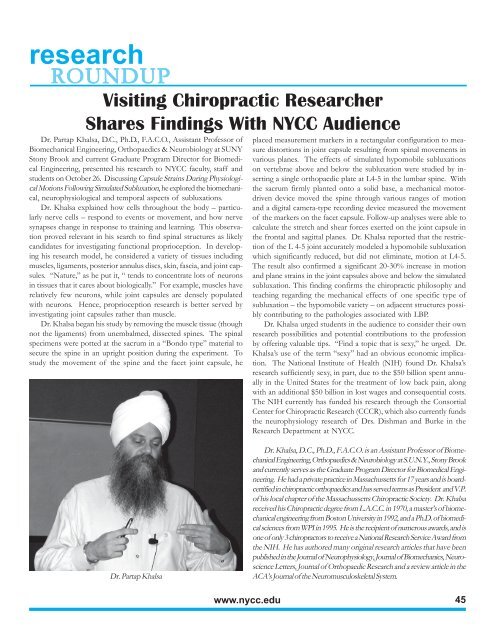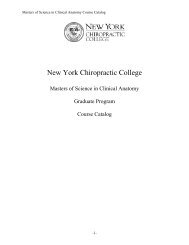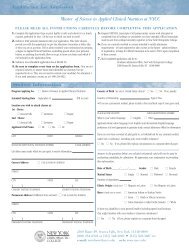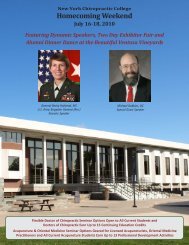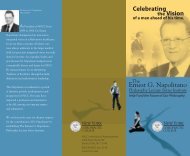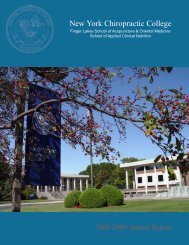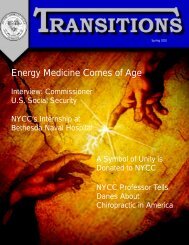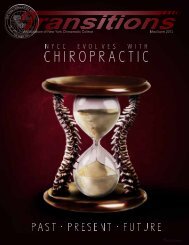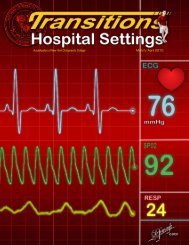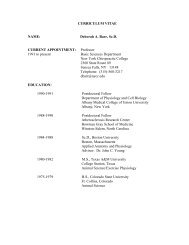2502 NYCC TRANS FINAL2 - New York Chiropractic College
2502 NYCC TRANS FINAL2 - New York Chiropractic College
2502 NYCC TRANS FINAL2 - New York Chiropractic College
You also want an ePaper? Increase the reach of your titles
YUMPU automatically turns print PDFs into web optimized ePapers that Google loves.
esearch<br />
ROUNDUP<br />
Visiting <strong>Chiropractic</strong> Researcher<br />
Shares Findings With <strong>NYCC</strong> Audience<br />
Dr. Partap Khalsa, D.C., Ph.D., F.A.C.O., Assistant Professor of<br />
Biomechanical Engineering, Orthopaedics & Neurobiology at SUNY<br />
Stony Brook and current Graduate Program Director for Biomedical<br />
Engineering, presented his research to <strong>NYCC</strong> faculty, staff and<br />
students on October 26. Discussing Capsule Strains During Physiological<br />
Motions Following Simulated Subluxation, he explored the biomechanical,<br />
neurophysiological and temporal aspects of subluxations.<br />
Dr. Khalsa explained how cells throughout the body – particularly<br />
nerve cells – respond to events or movement, and how nerve<br />
synapses change in response to training and learning. This observation<br />
proved relevant in his search to find spinal structures as likely<br />
candidates for investigating functional proprioception. In developing<br />
his research model, he considered a variety of tissues including<br />
muscles, ligaments, posterior annulus discs, skin, fascia, and joint capsules.<br />
“Nature,” as he put it, “ tends to concentrate lots of neurons<br />
in tissues that it cares about biologically.” For example, muscles have<br />
relatively few neurons, while joint capsules are densely populated<br />
with neurons. Hence, proprioception research is better served by<br />
investigating joint capsules rather than muscle.<br />
Dr. Khalsa began his study by removing the muscle tissue (though<br />
not the ligaments) from unembalmed, dissected spines. The spinal<br />
specimens were potted at the sacrum in a “Bondo type” material to<br />
secure the spine in an upright position during the experiment. To<br />
study the movement of the spine and the facet joint capsule, he<br />
placed measurement markers in a rectangular configuration to measure<br />
distortions in joint capsule resulting from spinal movements in<br />
various planes. The effects of simulated hypomobile subluxations<br />
on vertebrae above and below the subluxation were studied by inserting<br />
a single orthopaedic plate at L4-5 in the lumbar spine. With<br />
the sacrum firmly planted onto a solid base, a mechanical motordriven<br />
device moved the spine through various ranges of motion<br />
and a digital camera-type recording device measured the movement<br />
of the markers on the facet capsule. Follow-up analyses were able to<br />
calculate the stretch and shear forces exerted on the joint capsule in<br />
the frontal and sagittal planes. Dr. Khalsa reported that the restriction<br />
of the L 4-5 joint accurately modeled a hypomobile subluxation<br />
which significantly reduced, but did not eliminate, motion at L4-5.<br />
The result also confirmed a significant 20-30% increase in motion<br />
and plane strains in the joint capsules above and below the simulated<br />
subluxation. This finding confirms the chiropractic philosophy and<br />
teaching regarding the mechanical effects of one specific type of<br />
subluxation – the hypomobile variety – on adjacent structures possibly<br />
contributing to the pathologies associated with LBP.<br />
Dr. Khalsa urged students in the audience to consider their own<br />
research possibilities and potential contributions to the profession<br />
by offering valuable tips. “Find a topic that is sexy,” he urged. Dr.<br />
Khalsa’s use of the term “sexy” had an obvious economic implication.<br />
The National Institute of Health (NIH) found Dr. Khalsa’s<br />
research sufficiently sexy, in part, due to the $50 billion spent annually<br />
in the United States for the treatment of low back pain, along<br />
with an additional $50 billion in lost wages and consequential costs.<br />
The NIH currently has funded his research through the Consortial<br />
Center for <strong>Chiropractic</strong> Research (CCCR), which also currently funds<br />
the neurophysiology research of Drs. Dishman and Burke in the<br />
Research Department at <strong>NYCC</strong>.<br />
Dr. Partap Khalsa<br />
Dr. Khalsa, D.C., Ph.D., F.A.C.O. is an Assistant Professor of Biomechanical<br />
Engineering, Orthopaedics & Neurobiology at S.U.N.Y., Stony Brook<br />
and currently serves as the Graduate Program Director for Biomedical Engineering.<br />
He had a private practice in Massachussetts for 17 years and is boardcertified<br />
in chiropractic orthopaedics and has served terms as President and V.P.<br />
of his local chapter of the Massachussetts <strong>Chiropractic</strong> Society. Dr. Khalsa<br />
received his <strong>Chiropractic</strong> degree from L.A.C.C. in 1970, a master’s of biomechanical<br />
engineering from Boston University in 1992, and a Ph.D. of biomedical<br />
sciences from WPI in 1995. He is the recipient of numerous awards, and is<br />
one of only 3 chiropractors to receive a National Research Service Award from<br />
the NIH. He has authored many original research articles that have been<br />
published in the Journal of Neurophysiology, Journal of Biomechanics, Neuroscience<br />
Letters, Journal of Orthopaedic Research and a review article in the<br />
ACA’s Journal of the Neuromusculoskeletal System.<br />
www.nycc.edu<br />
45


